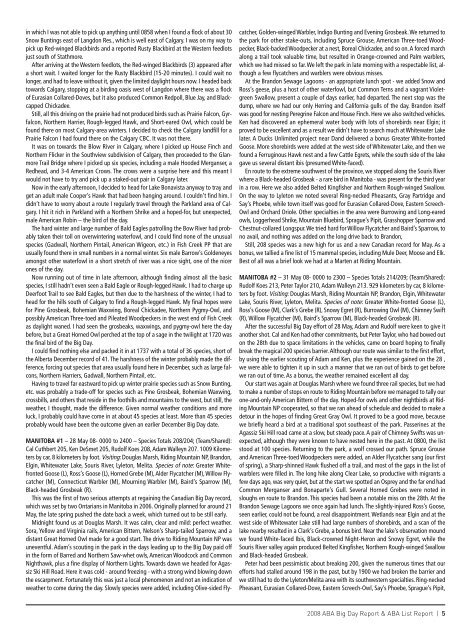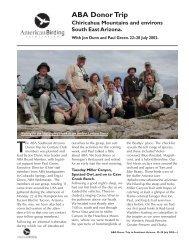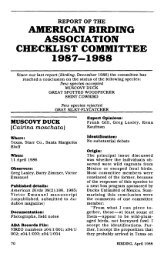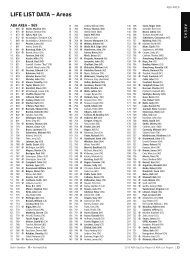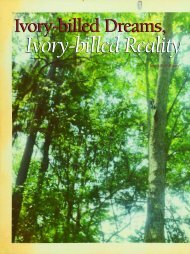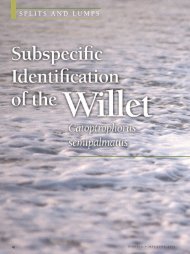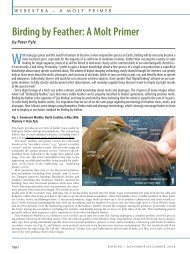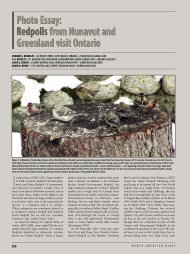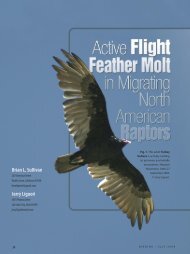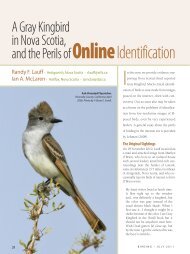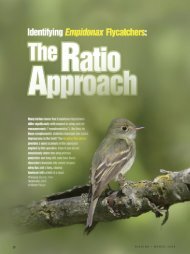Front End - American Birding Association
Front End - American Birding Association
Front End - American Birding Association
You also want an ePaper? Increase the reach of your titles
YUMPU automatically turns print PDFs into web optimized ePapers that Google loves.
in which I was not able to pick up anything until 0858 when I found a flock of about 30<br />
Snow Buntings east of Langdon Res., which is well east of Calgary. I was on my way to<br />
pick up Red-winged Blackbirds and a reported Rusty Blackbird at the Western feedlots<br />
just south of Stathmore.<br />
After arriving at the Western feedlots, the Red-winged Blackbirds (3) appeared after<br />
a short wait. I waited longer for the Rusty Blackbird (15-20 minutes). I could wait no<br />
longer, and had to leave without it, given the limited daylight hours now. I headed back<br />
towards Calgary, stopping at a birding oasis west of Langdon where there was a flock<br />
of Eurasian Collared-Doves, but it also produced Common Redpoll, Blue Jay, and Blackcapped<br />
Chickadee.<br />
Still, all this driving on the prairie had not produced birds such as Prairie Falcon, Gyrfalcon,<br />
Northern Harrier, Rough-legged Hawk, and Short-eared Owl, which could be<br />
found there on most Calgary-area winters. I decided to check the Calgary landfill for a<br />
Prairie Falcon I had found there on the Calgary CBC. It was not there.<br />
It was on towards the Blow River in Calgary, where I picked up House Finch and<br />
Northern Flicker in the Southview subdivision of Calgary, then proceeded to the Glanmore<br />
Trail Bridge where I picked up six species, including a male Hooded Merganser, a<br />
Redhead, and 3-4 <strong>American</strong> Crows. The crows were a surprise here and this meant I<br />
would not have to try and pick up a staked-out pair in Calgary later.<br />
Now in the early afternoon, I decided to head for Lake Bonavista anyway to tray and<br />
get an adult male Cooper’s Hawk that had been hanging around. I couldn’t find him. I<br />
didn’t have to worry about a route I regularly travel through the Parkland area of Calgary.<br />
I hit it rich in Parkland with a Northern Shrike and a hoped-for, but unexpected,<br />
male <strong>American</strong> Robin – the bird of the day.<br />
The hard winter and large number of Bald Eagles patrolling the Bow River had probably<br />
taken their toll on overwintering waterfowl, and I could find none of the unusual<br />
species (Gadwall, Northern Pintail, <strong>American</strong> Wigeon, etc.) in Fish Creek PP that are<br />
usually found there in small numbers in a normal winter. Six male Barrow’s Goldeneyes<br />
amongst other waterfowl in a short stretch of river was a nice sight, one of the nicer<br />
ones of the day.<br />
Now running out of time in late afternoon, although finding almost all the basic<br />
species, I still hadn’t even seen a Bald Eagle or Rough-legged Hawk. I had to charge up<br />
Deerfoot Trail to see Bald Eagles, but then due to the harshness of the winter, I had to<br />
head for the hills south of Calgary to find a Rough-legged Hawk. My final hopes were<br />
for Pine Grosbeak, Bohemian Waxwing, Boreal Chickadee, Northern Pygmy-Owl, and<br />
possibly <strong>American</strong> Three-toed and Pileated Woodpeckers in the west end of Fish Creek<br />
as daylight waned. I had seen the grosbeaks, waxwings, and pygmy-owl here the day<br />
before, but a Great Horned Owl perched at the top of a sage in the twilight at 1720 was<br />
the final bird of the Big Day.<br />
I could find nothing else and packed it in at 1737 with a total of 36 species, short of<br />
the Alberta December record of 41. The harshness of the winter probably made the difference,<br />
forcing out species that area usually found here in December, such as large falcons,<br />
Northern Harriers, Gadwall, Northern Pintail, etc.<br />
Having to travel far eastward to pick up winter prairie species such as Snow Bunting,<br />
etc. was probably a trade-off for species such as Pine Grosbeak, Bohemian Waxwing,<br />
crossbills, and others that reside in the foothills and mountains to the west, but still, the<br />
weather, I thought, made the difference. Given normal weather conditions and more<br />
luck, I probably could have come in at about 45 species at least. More than 45 species<br />
probably would have been the outcome given an earlier December Big Day date.<br />
MANITOBA #1 – 28 May 08- 0000 to 2400 – Species Totals 208/204; (Team/Shared):<br />
Cal Cuthbert 205, Ken DeSmet 205, Rudolf Koes 208, Adam Walleyn 207. 1009 Kilometers<br />
by car, 8 kilometers by foot. Visiting: Douglas Marsh, Riding Mountain NP, Brandon,<br />
Elgin, Whitewater Lake, Souris River, Lyleton, Melita. Species of note: Greater Whitefronted<br />
Goose (L), Ross’s Goose (L), Horned Grebe (M),Alder Flycatcher (M),Willow Flycatcher<br />
(M), Connecticut Warbler (M), Mourning Warbler (M), Baird’s Sparrow (M),<br />
Black-headed Grosbeak (R).<br />
This was the first of two serious attempts at regaining the Canadian Big Day record,<br />
which was set by two Ontarians in Manitoba in 2006. Originally planned for around 21<br />
May, the late spring pushed the date back a week, which turned out to be still early.<br />
Midnight found us at Douglas Marsh. It was calm, clear and mild: perfect weather.<br />
Sora, Yellow and Virginia rails, <strong>American</strong> Bittern, Nelson’s Sharp-tailed Sparrow, and a<br />
distant Great Horned Owl made for a good start. The drive to Riding Mountain NP was<br />
uneventful. Adam’s scouting in the park in the days leading up to the Big Day paid off<br />
in the form of Barred and Northern Saw-whet owls, <strong>American</strong> Woodcock and Common<br />
Nighthawk, plus a fine display of Northern Lights. Towards dawn we headed for Agassiz<br />
Ski Hill Road. Here it was cold - around freezing - with a strong wind blowing down<br />
the escarpment. Fortunately this was just a local phenomenon and not an indication of<br />
weather to come during the day. Slowly species were added, including Olive-sided Flycatcher,<br />
Golden-winged Warbler, Indigo Bunting and Evening Grosbeak.We returned to<br />
the park for other stake-outs, including Spruce Grouse, <strong>American</strong> Three-toed Woodpecker,<br />
Black-backed Woodpecker at a nest, Boreal Chickadee, and so on.A forced march<br />
along a trail took valuable time, but resulted in Orange-crowned and Palm warblers,<br />
which we had missed so far. We left the park in late morning with a respectable list, although<br />
a few flycatchers and warblers were obvious misses.<br />
At the Brandon Sewage Lagoons - an appropriate lunch spot - we added Snow and<br />
Ross’s geese, plus a host of other waterfowl, but Common Terns and a vagrant Violetgreen<br />
Swallow, present a couple of days earlier, had departed. The next stop was the<br />
dump, where we had our only Herring and California gulls of the day. Brandon itself<br />
was good for nesting Peregrine Falcon and House Finch. Here we also switched vehicles.<br />
Ken had discovered an ephemeral water body with lots of shorebirds near Elgin; it<br />
proved to be excellent and as a result we didn’t have to search much at Whitewater Lake<br />
later. A Ducks Unlimited project near Dand delivered a bonus Greater White-fronted<br />
Goose. More shorebirds were added at the west side of Whitewater Lake, and then we<br />
found a Ferruginous Hawk nest and a few Cattle Egrets, while the south side of the lake<br />
gave us several distant ibis (presumed White-faced).<br />
En route to the extreme southwest of the province, we stopped along the Souris River<br />
where a Black-headed Grosbeak - a rare bird in Manitoba - was present for the third year<br />
in a row. Here we also added Belted Kingfisher and Northern Rough-winged Swallow.<br />
On the way to Lyleton we noted several Ring-necked Pheasants, Gray Partridge and<br />
Say’s Phoebe, while town itself was good for Eurasian Collared-Dove, Eastern Screech-<br />
Owl and Orchard Oriole. Other specialties in the area were Burrowing and Long-eared<br />
owls, Loggerhead Shrike, Mountain Bluebird, Sprague’s Pipit, Grasshopper Sparrow and<br />
Chestnut-collared Longspur.We tried hard for Willow Flycatcher and Baird’s Sparrow, to<br />
no avail, and nothing was added on the long drive back to Brandon,<br />
Still, 208 species was a new high for us and a new Canadian record for May. As a<br />
bonus, we tallied a fine list of 15 mammal species, including Mule Deer, Moose and Elk.<br />
Best of all was a brief look we had at a Marten at Riding Mountain.<br />
MANITOBA #2 – 31 May 08- 0000 to 2300 – Species Totals 214/209; (Team/Shared):<br />
Rudolf Koes 213, Peter Taylor 210, Adam Walleyn 213. 929 kilometers by car, 8 kilometers<br />
by foot. Visiting: Douglas Marsh, Riding Mountain NP, Brandon, Elgin, Whitewater<br />
Lake, Souris River, Lyleton, Melita. Species of note: Greater White-fronted Goose (L),<br />
Ross’s Goose (M), Clark’s Grebe (R), Snowy Egret (R), Burrowing Owl (M), Chimney Swift<br />
(R), Willow Flycatcher (M), Baird’s Sparrow (M), Black-headed Grosbeak (R).<br />
After the successful Big Day effort of 28 May, Adam and Rudolf were keen to give it<br />
another shot. Cal and Ken had other commitments, but Peter Taylor, who had bowed out<br />
on the 28th due to space limitations in the vehicles, came on board hoping to finally<br />
break the magical 200 species barrier.Although our route was similar to the first effort,<br />
by using the earlier scouting of Adam and Ken, plus the experience gained on the 28 ,<br />
we were able to tighten it up in such a manner that we ran out of birds to get before<br />
we ran out of time. As a bonus, the weather remained excellent all day.<br />
Our start was again at Douglas Marsh where we found three rail species, but we had<br />
to make a number of stops en route to Riding Mountain before we managed to tally our<br />
one-and-only <strong>American</strong> Bittern of the day. Hoped-for owls and other nightbirds at Riding<br />
Mountain NP cooperated, so that we ran ahead of schedule and decided to make a<br />
detour in the hopes of finding Great Gray Owl. It proved to be a good move, because<br />
we briefly heard a bird at a traditional spot southeast of the park. Passerines at the<br />
Agassiz Ski Hill road came at a slow, but steady pace. A pair of Chimney Swifts was unexpected,<br />
although they were known to have nested here in the past. At 0800, the list<br />
stood at 100 species. Returning to the park, a wolf crossed our path. Spruce Grouse<br />
and <strong>American</strong> Three-toed Woodpeckers were added, an Alder Flycatcher sang (our first<br />
of spring), a Sharp-shinned Hawk flushed off a trail, and most of the gaps in the list of<br />
warblers were filled in. The long hike along Clear Lake, so productive with migrants a<br />
few days ago, was very quiet, but at the start we spotted an Osprey and the far end had<br />
Common Merganser and Bonaparte’s Gull. Several Horned Grebes were noted in<br />
sloughs en route to Brandon. This species had been a notable miss on the 28th. At the<br />
Brandon Sewage Lagoons we once again had lunch. The slightly-injured Ross’s Goose,<br />
seen earlier, could not be found, a real disappointment. Wetlands near Elgin and at the<br />
west side of Whitewater Lake still had large numbers of shorebirds, and a scan of the<br />
lake nearby resulted in a Clark’s Grebe, a bonus bird. Near the lake’s observation mound<br />
we found White-faced Ibis, Black-crowned Night-Heron and Snowy Egret, while the<br />
Souris River valley again produced Belted Kingfisher, Northern Rough-winged Swallow<br />
and Black-headed Grosbeak.<br />
Peter had been pessimistic about breaking 200, given the numerous times that our<br />
efforts had stalled around 198 in the past, but by 1900 we had broken the barrier and<br />
we still had to do the Lyleton/Melita area with its southwestern specialties. Ring-necked<br />
Pheasant, Eurasian Collared-Dove, Eastern Screech-Owl, Say’s Phoebe, Sprague’s Pipit,<br />
2008 ABA Big Day Report & ABA List Report | 5


